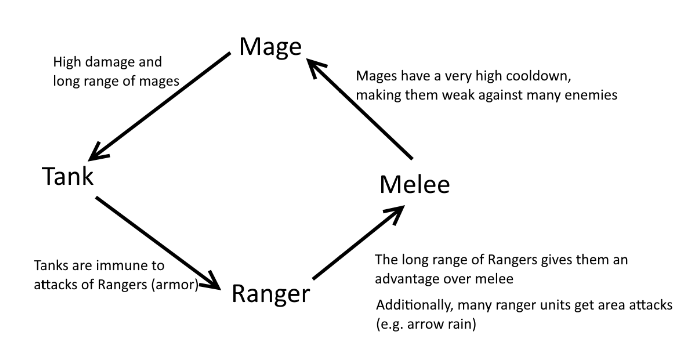King Mir said:
To pile on to the suggestions;
- Make the hitpoints of the castle relatively small. Since the game does lend itself to one player getting dominance relatively quickly, you don't want to drag out the battle when it's clear who's going to win.
- A game like this is all about having a good rock-paper-scissors system. For example mounted beats archers, who beat infantry, who beat mounted. For this to work, you need to force players to chose between three or more options, instead of sending out all unit types at once. One way to do may be to have a high unit cost, so players simply can't afford to send all unit types.
- Along the lines of point 2, provide buffs to having a lot of the same unit type. This fights the natural advantage a balanced army has. This can be in the form of another unit that helps all units of the same class. For example a general that leads your infantry, or an apprentice that powers up your mages.
- Make sure every unit has a weakness. If someone gets an brief advantage by spamming one unit type, it should be easy to counter that the next round (but of course a better player will anticipate the counter, and spam units to counter the counter).
- Make each faction feel unique by giving each an advantage for a particular player strategy.
- In a game like this you have two metrics of how well you're doing: the number and streangth of units in play, and the position of the line of scrimmage. Try to make it possible for these not to match. For example, have units who knock back the enemy without dealing a lot of damage, and have slow moving powerful units.
- Make sure the play area is wide enough so that as a player is loosing the line of scrimmage, they gain the benefit of reacting better because they can see which enemy's units are on the way.
- Area attacks are a counter for large numbers of units. Percent of max hp attacks are a counter to singular strong units. Include both.
- Make sure you have a test mechanism that tests the balance of each strategy and faction. Game-play telemetry is useful too, if possible.
- That would be one possibility, yet I think it would be better to find a way for the player to successfully defend the castle against even a big army and to launch a counter attack. It is true, that during one match (/game) in one battle, there, usually, is one clear winner (the stronger army destroys all enemies), however, the goal is, that there are multiple battles during one game. The player should still have the possibility to destroy the army of the enemy after some time. Possibly, because of tactical elements, such as 'rock, paper, scissor'-like unit types or, for example, area attacks
- I agree and have one more comment, which I will add to point 3
- this is a great point. The player should have an advantage by having many units of the same type, otherwise he will simply build a very balanced army. Maybe the following: The main attribute of the unit (e.g. health for tanks, damage for mages, range for rangers) is boosted, based on the amount of units of that type. For example, more tanks results in even more health and more mages results in even more damage. This is a really good idea.
- Similar to point 2 and 3. If we use the rock, paper, scissor system and boost groups of the same unit type, this would apply
- Would be ideal and we should definitely invest time into this topic. Probably not very easy, because there are over 20 tribes, yet, I guess, it would be okay, if there are some overlaps
- Already the case, to a certain degree: Units can have armor (makes immune to mage/ranger attacks), which makes those units very slow
- Yeah, although there needs to be a good balance. Otherwise, it might be frustrating: If you build a good army, which finally arrives at the enemy, but the enemy builds an effective counter (he has a lot of time to react, because he knows exactly who is coming to him) and you do not have any ways of helping your army, because support would take too much time to arrive, this would be frustrating
- Good idea. Especially the area attacks. I am not sure about the ‘Percent of max hp attacks’, because they might be too op against Heros and, otherwise, useless against everyone else. Possibly a viable special attack with a big cooldown
- Yes, I agree. We already set up Python tooling, which can automatically simulate matches and print out statistics of the resulting matches. The game simulation depends on the AI, though. If we succeed, we will use reinforcement learning to train a good AI
merkutsam said:
Is the game intended for 2 human players or single player vs AI? AI will always be at a disadvantage against humans so either you make a very good AI or you give aids-cheats.
You say you want to avoid one player holding attacks until he can overwhelm the other. So the gameplay would be about sequence, the player tries to produce units in the right sequence, countering enemy units and sending their heavy hitters at the right moment to destroy enemy castle. King Mir had very good suggestions to implement for this gameplay.
Don't give armor to shooters and mages or they will steamroll everything. Also King Mir mentioned Area attacks to counter numbers, then you need a unit resistant to area attacks to counter the former.
attacks of the units can destroy each other (e.g. fireball destroys flying axe or arrow destroys boomerang), based on the strength of the corresponding attacks
The problem of 1 Dimension and missiles collidig whith each other is that once a formation is able to overcome the enemy firepower it will destroy everything behind, and it's unlikely the enemy will be able to amass enough firepower to tip the balance again. I suggest to rethink that mechanic implementing King Mir ideas about rock, paper, scissors.
I like the idea of a wide space between castles so the batlle moves back and forth. Maybe add a mechanic to send a builder to a specific point and build a specific building there.
The game is intended for both. In the beginning, human vs AI. Later, we want to support human vs human too. The game, already, is deterministic (if the same hardware is used) and human vs human should be possible, but probably is still a lot of work to implement.
Yeah, the AI should be really good, which is why we are trying to train it with reinforcement learning. Additionally, we already wrote some balancing helpers: the money, which the AI gets, is multiplied with a balancing factor. This balancing factor depends on the worth of assets (money/units/building) the AI has in comparison to the enemy. The AI can get up to 1.5 times as much money, as usual, if it is very poor, compared to the enemy.
Yep, the game is about sequences of units and battles.
Regarding the 1 Dimension issue: this is, in general, correct, yet via mechanisms, such as a rock, paper, scissors system and the other ideas discussed above (e.g. area attacks or special attacks of the heros, with a big cooldown) it should be possible for a player to turn the game around to their advantage.
The possibility of building buildings at any position is something we have to test out. Maybe it is really good, maybe it is overpowered.
King Mir said:
merkutsam said:
Is the game intended for 2 human players or single player vs AI? AI will always be at a disadvantage against humans so either you make a very good AI or you give aids-cheats.
You should probably do both. Have a difficulty scale for AI buffs, and do your best to make a smart AI.
merkutsam said:
Don't give armor to shooters and mages or they will steamroll everything. Also King Mir mentioned Area attacks to counter numbers, then you need a unit resistant to area attacks to counter the former.
A unit resistant to area attacks is simply a unit with high hp or armor. The trade off is lots of weak units, or one strong unit.
Right now, we have the unit types Hero, Tank, Melee, Ranger, Mage. The tank, for example, has a lot of health, but only a short range attack. Additionally, units can wear armor, which makes them immune to attacks of rangers/mages (long range attacks). Units with armor are very slow.
Ok, So melee is cheep and has large numbers, and is strong against rangers. A mage can have an area attack to be good against that. A tank has armor, so counters a mage, and also the low attack of melee. Then maybe your hero deals damage proportional to max health, so counters both mages and tanks. And a ranger is also cheap, but has a bonus against tanks. There you go, 5 way RPS system.
For example.
Then give each faction a special unit or ability that boosts one or 2 of those 5 unit types.
Another thing, you mentioned that you have a healing fountain. I actually think you should avoid having abilities that heal units, because they keep units on the field. You might still be able to make it work if you favor certain unit types. For example, heal hp at a fixed number per second, so that it favors cheep units, and make this a faction special ability, for, say, snowmen.
Yeah, the healing fountain should have a very limited amount of heal hp per second.
Regarding the rock, paper scissor topic: right now, I consider the following system:
- Tank simply has high health but has no other big advantage. Also it has a low range
- Melee is rather cheap, deals a decent amount of damage, has a low range, has medium health and is very effective against buildings (which have a lot of health and are, otherwise, hard to destroy). The more melee units are close together, the more damage they deal
- Ranger has a high range, low health, medium damage and is effective against tanks. The more ranger units are close together, the more range they have (yet not too much, otherwise it would be very op)
- Mage has a high range, very low health and high damage. The more mages are close together, the more damage they deal







